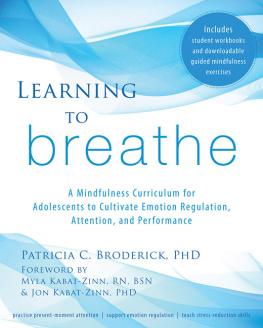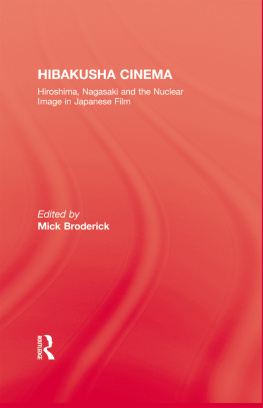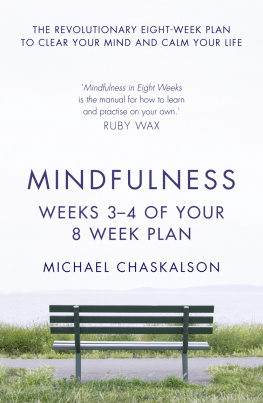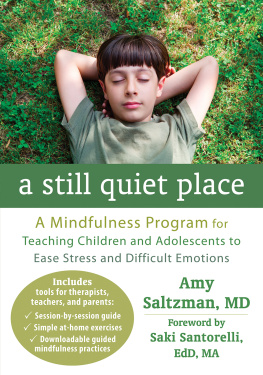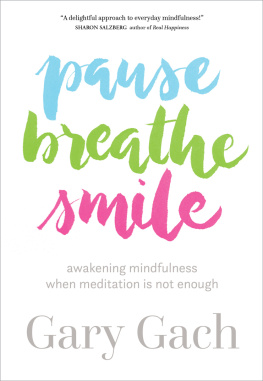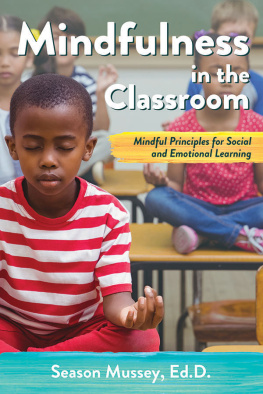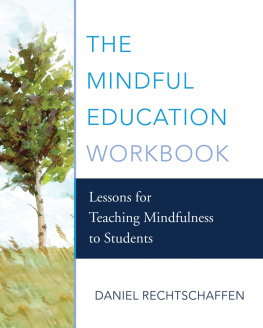Patricia C. Broderick, PhD, is a research associate at the Prevention Research Center for the Promotion of Human Development at Penn State University and founder of the Stress Reduction Center at West Chester University of Pennsylvania. She is a licensed clinical psychologist, a certified school psychologist and counselor for grades K 12, and she is a graduate of the Mindfulness based stress reduction (MBSR) advanced practicum at the Center for Mindfulness at UMASS. In addition, she is the author of The Life Span: Human Development for Helping Professionals, a textbook for graduate level students and mental health professionals.
Foreword writer Myla Kabat Zinn, RN, BSN, spent a number of years assisting at births both in the hospital and at home. During those years she also taught childbirth education classes based on mindful awareness. She is the coauthor, with her husband Jon, of Everyday Blessings: The Inner Work of Mindful Parenting. She has lead workshops on mindful parenting in the U.S. and in Europe.
Foreword writer Jon Kabat Zinn, PhD, is internationally known for his work as a scientist, writer, and meditation teacher engaged in bringing mindfulness into the mainstream of medicine and society. He is professor of medicine emeritus at the University of Massachusetts Medical School and author of numerous books, including Full Catastrophe Living, Arriving at Your Own Door, and Coming to Our Senses.

I have had an opportunity to use the BREATHE program with a cohort of first semester college undergraduates. The move to college creates unique challenges, and the BREATHE program, which can be adapted for this population, provides powerful tools to help emerging adults manage this transition. Learning the basics of mindfulness, strengthening emotion recognition and emotion management skills, and developing compassion for self and others, are all extremely important skills for college students.... As Broderick writes, there is a difference between knowing about emotions and knowing your own emotions as they are experienced. The BREATHE program allows this distinction to emerge brilliantly.
Sandra Kerr, PhD, professor in the department of psychology, West Chester University, PA
As a longtime instructor of mindfulness-based stress reduction, currently teaching instructors in two school districts, Brodericks book, Learning to Breathe, is a welcome gift. It is filled with clear information about mindfulness, from both the educational and neurological perspectives, and presents an excellent, thorough, and complete curriculum for adolescents. This book will be welcomed, used, and gratefully received by teachers and students.
Ferris Buck Urbanowski, MA, mindfulness instructor, South Burlington, Vermont School District, and Washington West School District, Waitsfield, VT
Learning to Breathe is an invaluable resource for those looking to share mindfulness with adolescents. Broderick has carefully crafted a professional and wonderfully straightforward mindfulness curriculum that can be used in a variety of settings. Highly recommended!
Doug Worthen, mindfulness teacher at the Middlesex School in Concord, MA
Learning to Breathe couldnt have come at a better time! Educators are seeking new ways of meeting a rising tide of societal challenges. Compelling new research supports the benefits of learning a mindfulness practice. With a focus on adolescents, Broderick has intelligently created a flexible mindfulness curriculum that is user-friendly, evidence-based, and age-appropriate. Through this achievement she offers the opportunity to experience burgeoning self-awareness, self-regulation, and the emotional balance that supports fully engaged learning and well-being. Ideally, all schools would teach these practices.
Marilyn Webb Neagley, education consultant, coeditor of Educating from the Heart, and author of Walking through the Seasons
Engaging, varied, and user-friendly lessons make this an essential resource for any educator who wishes to bring mindfulness into the curriculum. From theory to practice, this guide provides teachers with the necessary information to make mindfulness come to life in their classrooms and in the lives of their students. A must-have for all those committed to the social and emotional health of adolescents.
Karen Bluth, research fellow at the Program of Integrative Medicine at the School of Medicine at University of North Carolina, NC
Learning to Breathe is an extraordinary curriculum, grounded in a deep understanding of adolescent learning, adolescent growth, and the daily experience of adolescent life. The brilliant design of the BREATHE program provides teachers with ease in implementation and flexibility to adapt for the uniqueness of each class, while at the same time providing the quintessential elements of mindfulness-based well-being in each lesson. Educators and school systems that adopt this creative program will be giving a gift to themselves and to the adolescents in their care for a healthier, more positive and productive future.
Irene McHenry, PhD, licensed psychologist, author, international speaker and workshop presenter, and currently executive director of Friends Council on Education
The unfolding field of mindfulness education for tweens and teens is most fortunate to be gifted with Brodericks theoretically grounded and pragmatically written step-by-step guide. Broderick offers first-hand experiences and clear insights to encourage teachers and therapists teaching mindfulness practices to deepen their own practice while teaching and learning alongside youths. When offered in the spirit with which it is written, the Learning to Breathe curriculum opens a conversation around the often overwhelming stressors that are simultaneously unique and universal to preadolescents and adolescents while offering them an array of exercises to meet the stressors with more clarity and care. In doing so, these exercises for youths can introduce a new way of being in the world that frees young people from automatic avoidance and risk-taking behaviors that often compound their stressthereby decreasing experiences of distress and increasing experiences of empowerment. Let the exploration begin!
Laura J. Pinger, MS, senior outreach specialist at the Center for Investigating Healthy Minds at the Waisman Center on the University of Wisconsin-Madison
I have seen first-hand the transformational potential Learning to Breathe has for a wide range of students in the high school setting. Broderick has done an amazing job of creating a mindfulness-based universal prevention program for high school applications. Those looking for a program to use to bring mindfulness to high school students in a curricular way need not look further than Learning to Breathe.
Todd D. Cantrell, house principal at Central Bucks High School West in Doylestown, PA
I am delighted to provide an unequivocal endorsement of Brodericks Learning to Breathe. This program for adolescents is beautifully designed and hits all the right notes for teaching mindfulness as a tool to navigate the ups and downs of adolescence. Grounded within a developmental framework and clinical understanding of adolescent issues, Brodericks book is user-friendly and will resonate with clinicians, educators, and parents alike. As a school social worker with experience of successfully implementing [the program] within a very diverse population, it is gratifying to have a program of this integrity that is compatible with multiple areas of the curriculum.
Next page
